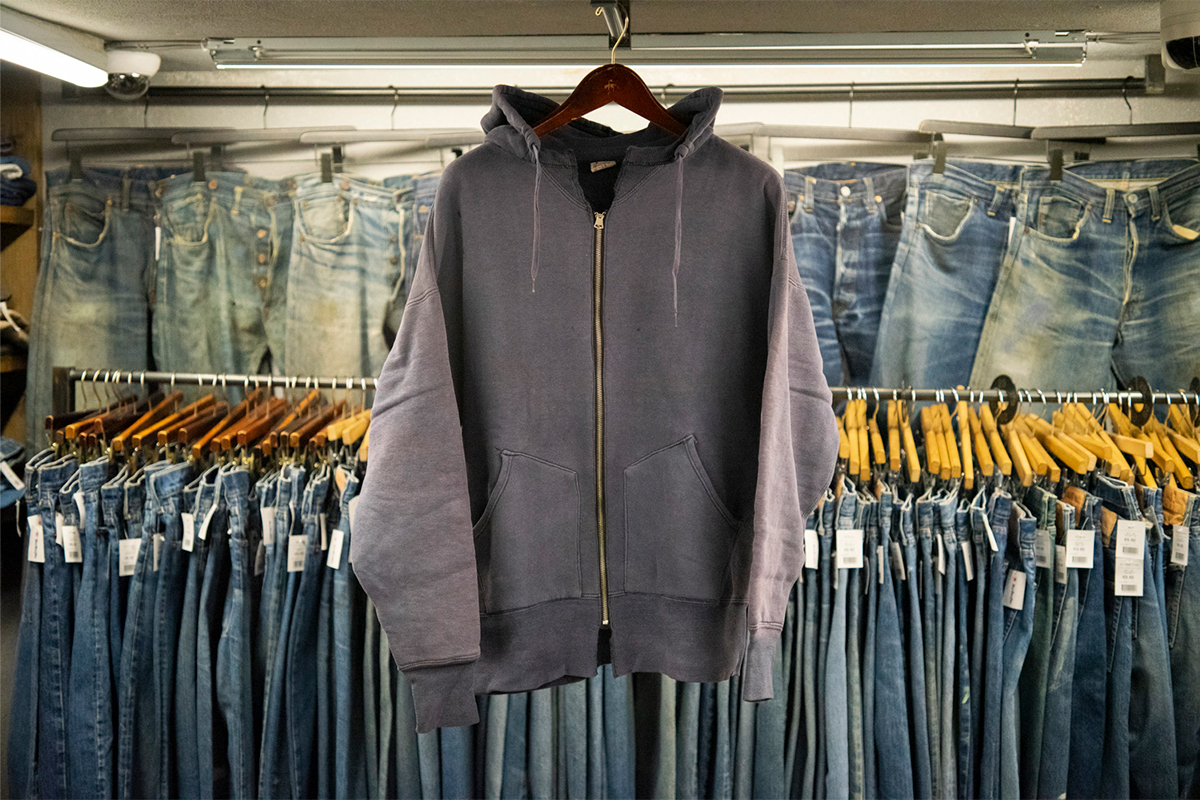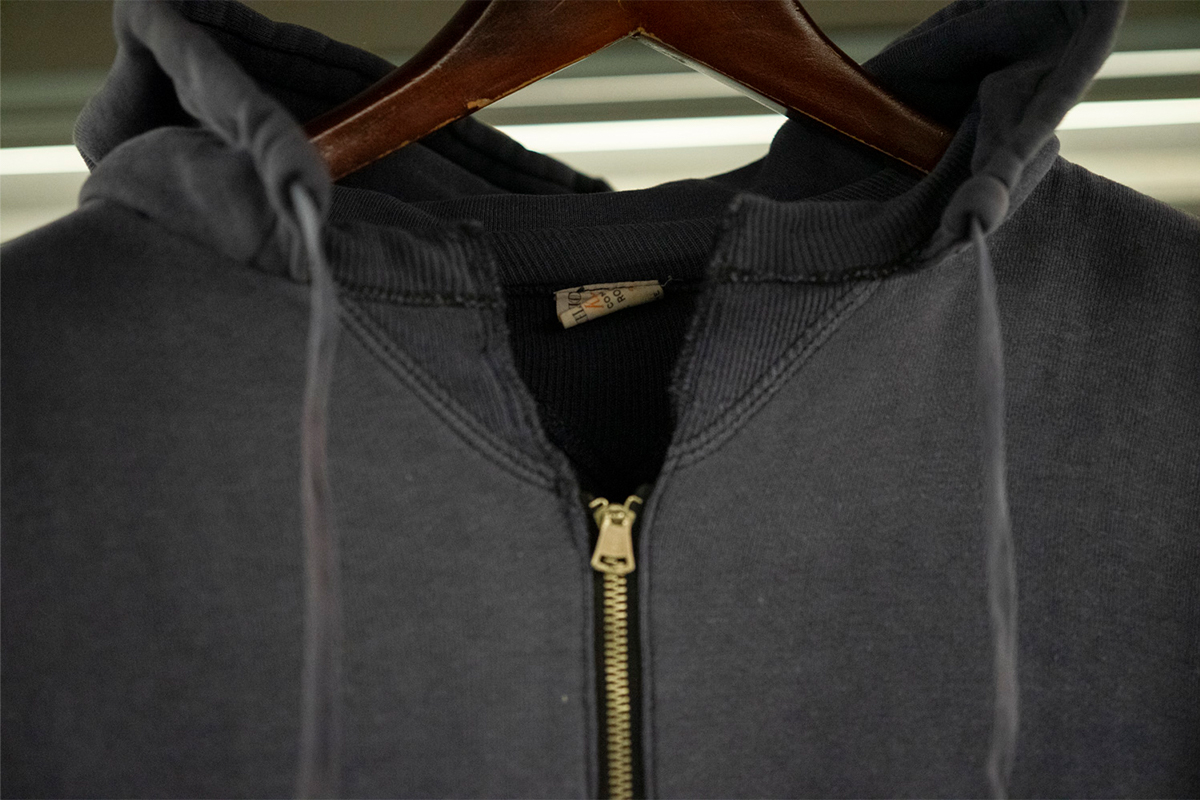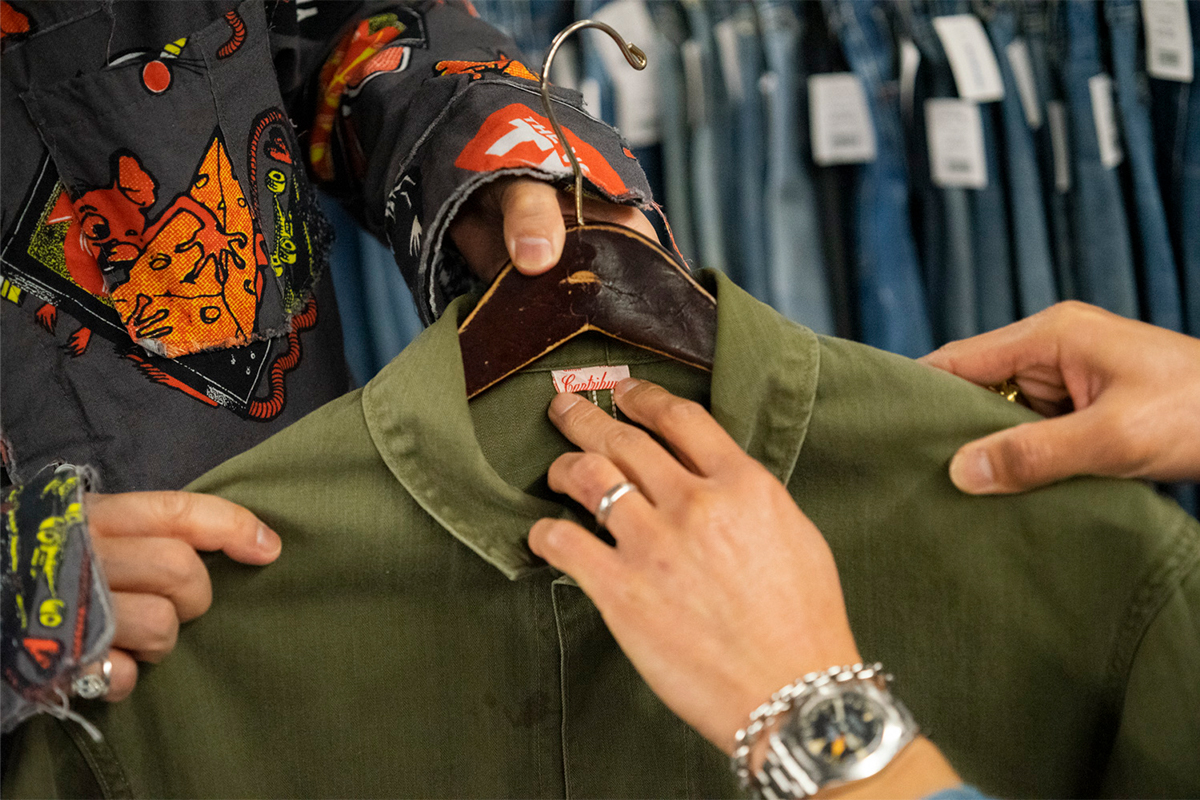TALKING ABOUT ARCHIVES Vol.25
Motofumi “POGGY” Kogi talks the relationship between archive and fashion; vol.03 feat. Yutaka Fujiwara(BerBerJin) (Part 2 of 2)
From high end fashion to street fashion, the concept of the archive is inseperable from the modern fashion world. To find out what influence the concept of the archive has on the creations of different brands, in this series we welcome Motofumi ‘Poggy’ Kogi and another guest to discuss this question. For this third instalment, we invited the man who is even trusted by Levi’s when it comes to vintage denim jeans; Mr. Yutaka Fujiwara from BerBerJin. From the BerBerJin store that all vintage-lovers visit, located in Harajuku’s Tonchan Street, we bring you this discussion between these two men.


--- This is one of those parkas with the hood attached afterwards by Champion, right?
Fujiwara: “Before I joined BerBerJin, I was a big fan of Champion. I sold a single item of this model once, but that was over ten years ago. But then the size didn’t fit the customer who bought it, so I ended up buying it back from them again. The design is often known as a run-ner’s tag; you can see it’s curled as well. Usually with these the hood is clipped onto the body, but here it’s slightly different, which is the way it was produced in the thirties.”


POGGY: “The thirties…”
Fujiwara:”I like both indigo and navy blue, and also the feeling of the colour slowly fading away. Among these parkas, this one is known as the best model, with a V on both sides, the pockets also separately attached and a print on the back. Even among other parkas like this, this one has everything. However, with this one a zipper has been attached and it has been custom-ized, so as far as prices go, this one was slightly cheaper. I’ve never actually worn this item while working in the store, because I just know customers are going to beg me to sell it to them if I do.”
POGGY: “If you managed to find one that doesn’t have a zipper in this condition, how much do you think it would sell for?”
Fujiwara: “Last year as well as this year, we haven’t actually had any of these models with a V on both sides with separate pockets in our store. The last time one turned up, it was sold for 398.000 yen. Sweaters have been leaping up in price since last year. Especially the older ones. Items like this, or other ones with two colours can easily go up into three digits; the extreme fans are getting heated up these days.”
--- Is there any particular reason for that?
Fujiwara: “I think the fact that these days those fans use Instagram as a tool to connect with eachother and exchanging information is a big thing; it also means that people are going to try and find an item to impress each other. Besides that, last year was Champion’s 100th birthday, so there were several magazines that did a special on vintage sweaters. That’s when the scene started going wild and it became more difficult to find any of these items. Talking about Cham-pion, I think reverse weave items are also starting to be a hot item these days. A remake hype has been going on the last few years and so a few thousand remake reverse weave items have also been made; this also meant that the original, the real thing got a lot of renewed attention as well. It’s also unisex so it can also be worn as an oversized item for women. We buy quite a lot of these items every month, but in the end they’re sold out every time. That’s how popular Champion still is these days.”
POGGY: “Also, at &BerBerJin, they sometimes offer you the possibility to buy something that is kind of ruffled up on purpose, which is also interesting. Something like that is actually often-times harder to find.”
--- Is that different from ruffling it up by yourself?
POGGY: “It’s difficult, but I feel it just doesn’t have the same feeling if you do it yourself.”
Fujiwara: “If you try to rip it up slightly, you can get horizontal lines in there as well”
POGGY: “Yup, in the end you just have to wear the item a whole lot.”


Fujiwara: “I like work wear items as well, and there was a period I bought those kinds of items in bulk as well. This spring coat is exactly my size and also have a kind of military touch as well, with the green herringbone pattern which is really nice. It’s from a brand called Cantshill which was producing from the end of the thirties to the forties. I bought it together with only two removable buttons, so I was trying to look for the other ones but they were pretty difficult to get a hold of. I did however have three Hartt buttons at home the most famous places in re-movable buttons, Carhartt. These were actually from the end of the twenties, so the characters identifying it as Carhartt weren’t used back then just yet. Slightly newer buttons do have the word ‘Carhartt’ written on them. If you were to use Carhartt buttons on an item it immediately becomes a Carhartt item, but using these old Hartt buttons it works fine.”

--- I see you have your own thoughts on the matter.
Fujiwara: “These Hartt buttons are just great from a design perspective while also being cute, so while the jacket itself has a kind of dirty feel to it, it does score high points from the girls. Mr. Kogi and me, we both love Carhartt after all. I’ve been wearing this item for over five years now, and there’s still people once in a while begging me to sell it to them.”
--- As a general rule when buying vintage items, do you only buy the kind of items you would wear youself?
Fujiwara: “Yes, basically everything. Clothes are meant to be worn after all.”
POGGY: “And you do, of course, wear them.”
Fujiwara: “There are items that I’ve stopped wearing over time. Not just because of the size, but merely because people will come and try to figuratively steal them. They just walk onto you and keep asking you to sell it to them, it’s actually kind of insane.”
All laugh.
POGGY: “The perfect example for that is probably this item.”

Fujiwara: ”It’s been thirteen years now since we became a part of the Fakeα chain, but in all that time I’ve managed to get my hand on only a single 501XX model. I’ve been wearing it for about ten years now, but it’s kind of oversized; I did feel the charm in wearing my own dead stock, so I found out my perfect size was 34/33 when talking about patch size, so that’s where I started look-ing. I wanted an item from the year I was born, which is 1977, but the materials used in denim items weren’t all that good at the time. I wanted to let it evolve by itself from its original colour as well, so I gave up on the year 1977 and went looking for something from the seventies; this item is from 1974. I looked for about eight years, I think. I went through a lot of dead stock, but I think this one had the most colour left in it. I did the starching myself and wore it for the first time on my 40th birthday; I was really interested in what it would become like after wearing it for two years, so I would wear it every day I was working in the store. I ride my fixed-gear bike to the sta-tion for ten minutes every day, so that made a difference as well. I tried to use it as normal as pos-sible, so I’ve spilled things on it like alcohol or even the ramen I ate at five in the morning. I’ve even been asked about that one black stain over here.
After about a year and seven months, the fabric around the crotch started to rip apart. So, I asked a lot of people for their opinion, but the consensus was that it would get worse and worse if I kept wearing it, so I stopped wearing it after that. The first time I washed it was just to take the dust off, and after that I kept on wearing it for a year and seven months until washing it again. Which means I’ve only washed it two times total. If you imagine a pair of denim jeans that’s only been washed twice, you’d think the colour stays pretty much the same. This was a good chance for me to prove just how much colour disappears from just the friction that comes with wearing it!”

POGGY: “People who really like denim often like this kind of faded colour. The kind that ap-pears out of itself; back in the day you bought a pair of jeans as workwear and just keep on wearing it for ever and ever. That’s the kind of idea that Yutaka tried to do in this era as well. A friend of both mine and Yutaka who’s been in the business longer that both of us gave me a 1976 pair of denim jeans when I went solo as a present. The thing is, that was from the dead stock that Yutaka found. That’s actually the pair of jeans I’m wearing right now, but it doesn’t really go as easy as you think.”
Fujiwara: “You can’t keep on wearing the same pair of jeans every day, right?”
POGGY: “I do that sometimes! For me, I’ve tried to let some of the colour fade off by pressing a clothing iron on the central pleats. I feel like wearing a pair of denim jeans from your own year of birth is probably a privilege for those over 42 these days.”
Fujiwara: “That’s true.”
POGGY: ”Also, for most younger people, the items made in their year of birth probably won’t lose their colour in a good way like this item.”
Fujiwara: “That’s true. At the end of the seventies some developments occurred in dying tech-nologies and the materials used changed as well, so the fading of the colours isn’t the same as it used to be. The exact timing that it changed is hard to pinpoint, but as far as I’ve seen it hap-pened around 1975. From 1976, the colours start to be a bit different.”

--- Mr Kogi, what do you think is the most interesting thing about the fashion culture that’s evolved around these vintage items?
POGGY: “As Yutaka also said before, I think the most important thing is to enjoy the experi-ence of ‘wearing’ an item. There’s some people among the extreme fans who just never wear the items and just look at them in their own homes, but that’s not the way we see things. Changing up the buttons you use, finding an item made in the era you were born and wearing it until it turns into your own item, those are really enjoyable things. It’s also interesting to find an item that is worn-out in just the right way.”
Fujiwara: “Another important thing is that all of these items are really unique. The Brown Duck model that Kogi is wearing today by Carhartt is a good example; if you were to look for an item that has exactly the same feeling and colour, you’d never find it anywhere. There’s a lot of different aspects to the matter that strike just the right spot, which I think Kogi is also thinking about when he selects them. Whenever I buy a second-hand or vintage item, it’s often a case of love at first sight. It only happens really once in a while that I find an item that makes me feel like I’d really been looking for it; more often I just fall in love on the spot and buy it. That’s probably proof of the fact that I keep on using my own senses to look for these unique items.”
Yutaka Fujiwara
Director of one of the most well-known vintage shops in Japan, BerBerJin. He is especially knowledgeable in vintage denim items and worked together with others to publish『THE 501®XX A COLLECTION OF VINTAGE JEANS』, a publication describing the Levi’s 501 series of vintage wear in 2015. From 2018, he has started his own YouTube channel to further knowledge about the charm of vintage denim wear.
https://www.youtube.com/channel/UCexbqeATcS0nViTHqOzJYLg
Motofumi “POGGY” Kogi
Born in 1976. Started working part-time at UNITED ARROWS in 1997 and opened his own store, Liquor,woman&tears in 2006 after working for the press for a while. In 2010, he opened a new store called UNITED ARROWS & SONS, where he worked as director. In 2018 he went independent and is gathering attention for his various activities, like working as the fashion director for 2G, a store in the recently renewed Shibuya PARCO building.
Text_ Maruro Yamashita




